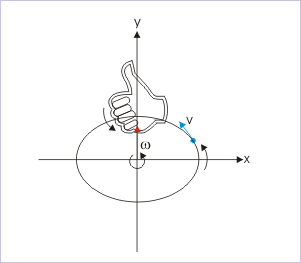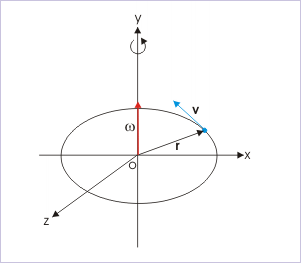| << Chapter < Page | Chapter >> Page > |
The vector angular quantities like angular velocity ( ω ) or ω (as scalar representation of angular vector) is represented by a vector, whose direction is obtained by applying “Right hand rule”. We just hold the axis of rotation with right hand in such a manner that the direction of the curl of fingers is along the direction of the rotation. The direction of extended thumb (along y-axis in the figure below) then represents the direction of angular velocity ( ω ).
Vector cross product

The important aspect of angular vector representation is that the angular vector is essentially a straight line of certain magnitude represented on certain scale with an arrow showing direction (shown in the figure as a red line with arrow) – not a curl as some might have expected. Further, the angular vector quantities are axial in nature. This means that they apply along the axis of rotation. Now, there are only two possible directions along the axis of rotation. Thus, we can work with sign (positive or negative) to indicate directional attribute of angular quantities. The angular quantities measured in counter clockwise direction is considered positive, whereas quantities measured in clockwise direction is considered negative.
This simplicity resulting from fixed axis of rotation is very useful. We can take the liberty to represent angular vector quantities in terms of signed scalar quantities as done in the case of linear quantities. The sign of the angular quantity represents the relative direction of the angular quantity with respect to a reference direction.
Analysis of angular motion involves working interchangeably between linear and angular quantities. We must understand here that the relationships essentially involve both axial (angular) and polar (linear) vectors. In this context, it is recommended that we know the relationship between linear and angular quantities in vector forms as vector relation provide complete information about the quantities involved.
If we want to write the relation for velocities (as against the one derived for speed, v = ω r), then we need to write the relation as vector cross product :
The order of quantities in vector product is important. A change in the order of cross product like ( ) represents the product vector in opposite direction. The directional relationship between thee vector quantities are shown in the figure. The vectors “ v ” and “ r ” are in the plane of “xz” plane, whereas angular velocity ( ω ), is in y-direction.
Linear and angular velocity

Here, we shall demonstrate the usefulness of vector notation. Let us do a bit of interpretation here to establish the directional relationship among the quantities from the vector notation. It is expected from the equation ( ) that the vector product of angular velocity ( ω ) and radius vector ( r ) should yield the direction of velocity ( v ).
Remember that a vector cross product is evaluated by Right Hand Rule (RHR). We move from first vector ( ω ) to the second vector ( r ) of the vector product in an arc as shown in the figure.

Notification Switch
Would you like to follow the 'Physics for k-12' conversation and receive update notifications?